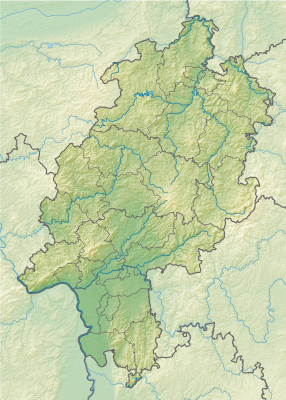Lichtenstein Castle (Greifenstein)
| Lichtenstein Castle | ||
|---|---|---|
|
Burgstall of the Lichtenstein |
||
| Alternative name (s): | Grünwieser Castle | |
| Creation time : | around 1225 (or 1255) | |
| Castle type : | Höhenburg, spur location | |
| Conservation status: | Burgstall | |
| Standing position : | Local nobility | |
| Place: | Greifenstein - Holzhausen | |
| Geographical location | 50 ° 36 '34.5 " N , 8 ° 16' 27.8" E | |
| Height: | 315 m above sea level NHN | |
|
|
||
The Castle Lichtenstein is an Outbound Spur castle on the 315 m above sea level. NN high Burgberg Lichtenstein near the Greifensteiner district Holzhausen on the former Hohen Straße , which led from Frankfurt via Wetzlar to Cologne, north above the Ulmbach dam in the Hessian Lahn-Dill district .
history
The small castle in the spur was probably built around 1225 by the Lords of Lichtenstein, close relatives of the Lords of Greifenstein . However, this is not clearly proven, because it is not certain whether Konrad von Lichtenstein, who is mentioned in a document in 1225 and 1229, also belonged to the Lichtenstein family in Greifenstein. Some secondary sources assume that the castle was only built around 1250 by the brothers Werner and Kraft von Lichtenstein. Like Greifenstein Castle, the castle was conquered and destroyed in 1298 by Counts Johann von Nassau († 1328) and Heinrich von Solms-Burgsolms († around 1313) as well as troops from the Wetterau imperial cities , as the Greifenstein and Lichtensteiners broke up had taken the side of the opposing king Albrecht von Habsburg and against King Adolf von Nassau , or because they, at least in the eyes of the Nassau and Solmser, presented themselves as robber barons.
In contrast to Greifenstein Castle, Lichtenstein was not rebuilt. The Lichtensteiners then probably lived on a farm in nearby Wallendorf (today part of Beilstein ). The ruins of their castle remained in their possession, then finally came to her husband Kraft von Rodenhausen with Irmgard, Wittekind von Lichtenstein's heir, with whom the male line died out . In 1363 he sold the castle hill along with the ruins and the other Lichtenstein goods that had fallen to him to Count Johann von Nassau-Hadamar († 1365).
In 1395 the castle hill and the Lichtenstein ruins came into the possession of the Counts of Solms. Johann II. Von Solms-Burgsolms , called "Springsleben" († 1405), who has resided in the now rebuilt Greifenstein Castle since the destruction of his castle in Burgsolms in 1384 by the Wetterau city union of the imperial cities of Wetzlar , Friedberg and Gelnhausen Son of Johann III. († 1415), the last of the Solms-Burgsolms line, acquired it in March 1395 from Count Philip I of Nassau-Saarbrücken-Weilburg , together with other property, Philip I in 1363 from Kraft von Rodenhausen and his wife Irmgard von Lichtenstein had acquired.
Current condition
Of the former castle complex, only the remains of the neck ditch below the mountain plateau and small remains of walls can be seen.
tourism
From the exit of the Greifenstein district of Greifenstein, the three-castles hike leads through Greifensteiner Land over 11 km past the ruins of Lichtenstein Castle to Beilstein and back. The hiking trail is marked with a black sign and the silhouette of Greifenstein Castle stylized in white. Over the Hohe Straße and Trompeters Loch it goes above the Ulmtalsperre to Beilstein. The way back leads past Straubersberg (425 m) back to Greifenstein.
literature
- Rudolph zu Solms-Laubach: History of the Count and Princely House of Solms . C. Adelmann, Frankfurt am Main 1865 ( digitized version [accessed on February 2, 2014]).
- Rudolf Knappe: Medieval castles in Hesse: 800 castles, castle ruins and castle sites. 3. Edition. Wartberg publishing house. Gudensberg-Gleichen 2000, ISBN 3-86134-228-6 , p. 292.
Web links
- Caspar Friedrich Gottschalk: The knight castles and mountain castles of Germany. Seventh volume, Schwetschke and Son, Halle 1829, pp. 316–317.
- Entry to Lichtenstein b. Beilstein in the scientific database " EBIDAT " of the European Castle Institute, accessed on November 21, 2019.
Individual evidence
- ↑ Solms-Laubach: History of the Count and Princely House of Solms . 1865, p. 27 .
- ↑ Beilstein, a historical overview. on: hgv-beilstein.de
- ↑ The year 1280 is often given as the year of destruction, as is the case with Solms-Laubach, p. 27, but this does not fit in with the alliance of princes against King Adolf .
- ↑ Solms-Laubach, p. 41.


